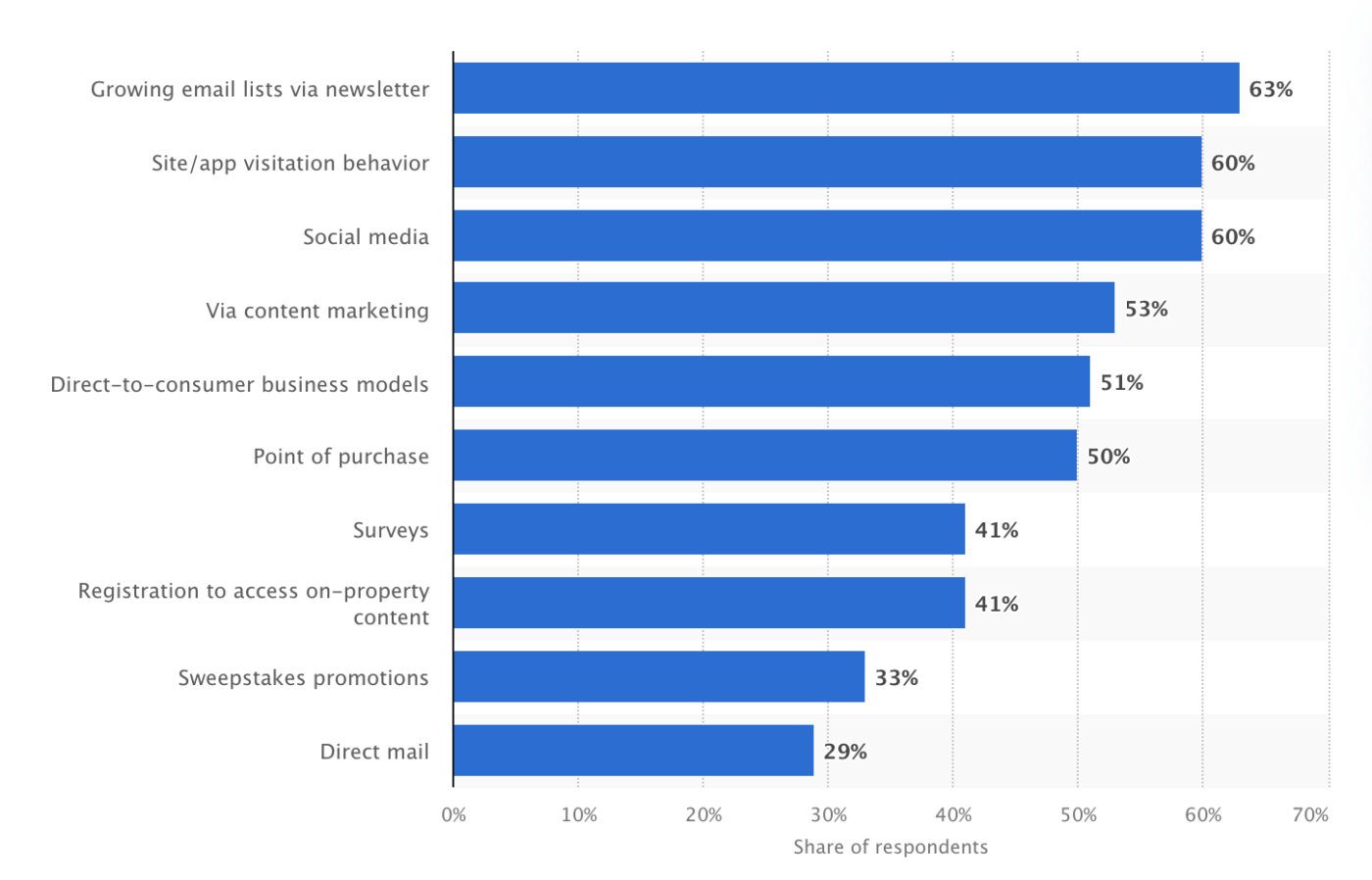According to Statista research from 2021, advertisers in the US increased their first-party data acquisition efforts in several ways. The top three methods for obtaining this data include an email newsletter, tracking website or app behavior, and social media interactions. First-party data is the only type of data that comes directly from your audience, which means you know exactly who the source is and can verify its validity.

This article will cover why brands may be looking to maintain more control over their data by using first-party over second-and third-party types, what first-party data is, why it matters, and how to collect it.
What is first-party data?
First-party data is information consumers willingly share with businesses. Companies can capture first-party data via social media conversations, emails, SMS, surveys, and customer service interactions.
For example, you can send an email survey to customers asking them about their interests, shopping habits, or what they’re looking for in a brand. You can then use this data to guide your marketing campaigns, targeted ads, and products—all without tracking or violating user privacy.
ManyChat enables you to acquire first-party data via chat marketing. For example, when you use Instagram Automation by ManyChat, you can create a quiz within your DMs that asks potential customers what they’re shopping for (e.g., women’s jackets, men’s shoes, etc.). Then you can use this information to tailor the content you show that user.
What is the value of first-party data?
First-party data is the only kind of information that doesn’t require an outside company to collect it. The party using the data is the same party that gathers it (i.e., you), which is valuable. Plus, it comes directly from your audience, which is exactly the group you’re trying to reach—there’s no middleman.
Why do marketers like first-party data?
First-party data helps marketers learn more about a target audience and tailor the content to match user preferences and proclivities. It’s also usually more affordable to capture since you can use your resources to collect it instead of paying an outside party. Furthermore, you don’t have to worry about your data supply suddenly disappearing.
Several search engines have done away with anything other than first-party data in response to recent data privacy laws. In fact, Google promised to stop using third-party cookies (a file that stores a user’s web-related data) by 2023.
Many businesses that rely on third-party data may be wondering how to move forward without it. But, if you already use only first-party data, you don’t have to worry.
At ManyChat, we are proud to help businesses use customer data that complies with privacy laws worldwide and practice what we preach. For example, we have never used third-party cookies. To learn more, read our privacy policy.
How is first-party data different from second and third-party data?
Remember that first-party data is information collected by the same company that plans to use it, like when your company acquires data from customers for use in future marketing campaigns.
If your company were to sell its first-party data to another company in the same industry, the buyer would be purchasing second-party data.
Third-party data is from an entirely outside source, i.e., the company selling the data isn’t even the company that collected it; it’s just a middleman. The downside of using third-party information is that you often don’t know the data source. Not only that, but if you purchase data (like email addresses), customers never opted in to hear from your brand specifically, which could lead to diminished results.
How to collect first-party data
Regardless of the type of information you want to collect, you’ll need software to acquire and manage it. The good news is that you may already have some of these types of tools built into your website or other marketing platforms you use.
Use analytics tools
One way to see how people navigate your website is by collecting behavioral data from online interactions by using tools such as Google Analytics or Google Search Console. These tools can show how many people visit your website, how long they stay on each page, and items they click.
Offer a subscription
Content users can subscribe to, such as a blog or a newsletter, can also contribute to data on visitors’ online behavior. You may notice trends among subscribers, open rates, or popular topics.
Tap into social media
If your business has social media profiles, you may be able to access some data on who follows you. For example, Instagram will show you demographic information and the times your followers are most active on the platform.
Look at purchase history
Another way to collect first-party data is via purchase history. What are customers buying from your online store?
Collect customer feedback
Customer feedback is an excellent source of first-party data. You could conduct a survey asking customers about their experience with your brand or look at customer reviews for your business on Google, product review websites, social media platforms, or your customer service team and identify trends—positive and negative—from there.
Common data collection challenges
While there are several different methods for first-party data collection, acquiring it is not without challenges.
One barrier is persuading users to participate and respond to your call for information. Sometimes, lengthy surveys or complicated forms annoy users to the point where they may not respond at all. Alternatively, they might fill in quick answers to finish as fast as possible—which doesn’t lend itself to your marketing efforts.
Other challenges can involve literacy or language comprehension. If a user doesn’t understand a question in a survey, they will find it difficult to provide an applicable answer. Depending on your target audience, you may leverage specific software to help with literacy or work with professional translators to ensure accuracy across languages.
Finding the right sample size that reflects your audience can be tricky; you don’t want a small number of survey results to dictate decisions for a large group. Some calculators can help you determine good sample size, or you could work with a statistician.
Once you acquire it, managing data can also be challenging. There are many ways to store first-party data; even if it’s all dumped into a spreadsheet, you still have to be able to organize it well enough so it’s worth analyzing for use in guiding your decisions.
Yet, when you have a handle on collecting and managing the data, you can use it to direct your targeting efforts. It’s well worth the effort!
Targeting with first-party data
One benefit of collecting first-party data is you can leverage it for ad targeting. When you target using data from your audience, you’re offering personalized content right from the source.
One way to approach this is by creating an ad audience composed of anyone who has visited your website, e.g., visitors who have landed on the homepage or browsed a particular product page.
With this audience in mind, create an ad relevant to their experience and add a matching call to action (CTA). For example, if the audience is made up of anyone who has visited the women’s shoe page, you could build an ad with a discount code for women’s shoes.
If you’re using ManyChat, you can tag users who’ve chatted with you. You can also create quizzes and ask them questions to provide a more personalized experience.
Here’s how it works in practice: Ask users what they’re shopping for, then tag them based on their answer and send them into a flow tailored to their interests. For example, if they are looking for men’s outerwear, you can tag them as part of your men’s outerwear audience segment so they’ll receive communication (promotions, discounts, new product offerings, etc.) geared towards men’s outerwear.
If you’re looking to acquire new customers, you can create a mirror audience (also called a lookalike audience). A mirror audience uses data from users who have already interacted with your brand in some fashion (clicked an ad, downloaded an asset, browsed your website, etc.) to form a new, similar audience you can market to.
The more data you can collect on your audience, the more accurate your lookalike audience will be, and you’ll see an even better return. Plus, you can utilize a lookalike audience at any point during the customer journey.
Generating first-party data is a smart move for your digital marketing strategy since you don’t have to rely on an outside party to get the information. If you’re not currently collecting it, start small and see what trends emerge. Use the data to help your marketing efforts and improve your customer experience.
Ready to collect first-party data with ManyChat?







